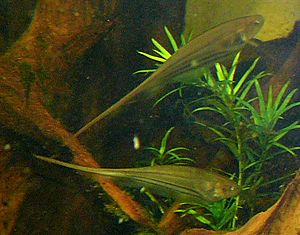Glass knifefish facts for kids
Quick facts for kids Glass knifefishes |
|
|---|---|
 |
|
| Eigenmannia virescens | |
| Scientific classification |
|
| Kingdom: | Animalia |
| Phylum: | Chordata |
| Class: | Actinopterygii |
| Order: | Gymnotiformes |
| Suborder: | Sternopygoidei |
| Superfamily: | Apteronotoidea |
| Family: | Sternopygidae Cope, 1871 |
Glass knifefishes are amazing fish that live in the fresh waters of Panama and South America. They belong to a fish family called Sternopygidae. You might also hear them called rattail knifefishes because of their long, thin bodies.
These fish are special because many of them are almost see-through! They are also very flat from side to side. Glass knifefishes have small, brush-like teeth and fairly large eyes. Their anal fin (the fin on their belly) starts right under their gills. Some of these fish can grow quite long, with the Sternopygus macrurus reaching up to 140 cm (about 55 inches)!
Glass knifefishes often live in fast-moving, deep parts of big rivers, like the Amazon River. They have even been seen swimming straight up and down! Some types, like Sternopygus species, can live in smaller streams too.
One unique thing about these fish is their ability to create a weak electric field. They use this field, called an electric organ discharge (EOD), to help them navigate, find food, and communicate in the dark or murky waters where they live. It's like having a built-in radar system!
Some types of glass knifefishes are popular in aquariums because of their interesting looks and behavior.
Types of Glass Knifefishes
There are about 30 different kinds of living glass knifefishes. Scientists group them into six main categories, called genera. Each genus contains one or more species.
Here are some of the main groups:
- Archolaemus
- Distocyclus
- Eigenmannia
- Japigny
- Rhabdolichops
- Sternopygus
One very special glass knifefish is Eigenmannia vicentespelaea. This is the only type of gymnotiform fish that lives only in caves!
Scientists have also found one fossil glass knifefish called Humboldtichthys kirschbaumi. It lived a very long time ago, during the Upper Miocene period. This fossil helps us understand how these fish have changed over millions of years.
See also
 In Spanish: Peces cuchillo de cristal para niños
In Spanish: Peces cuchillo de cristal para niños

